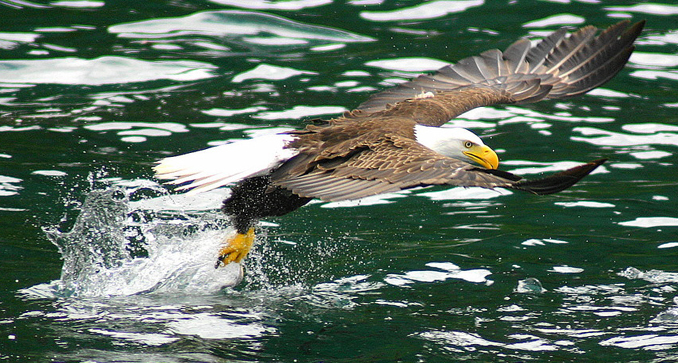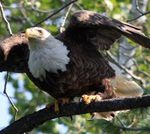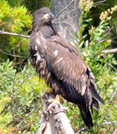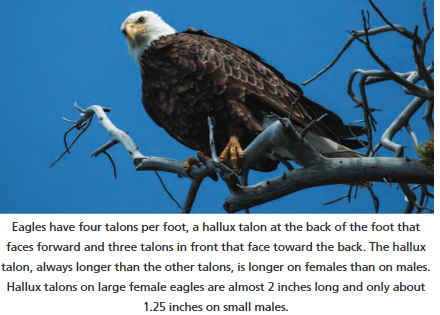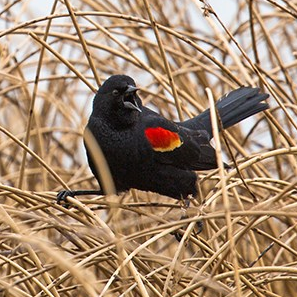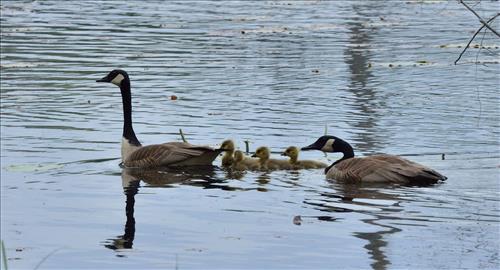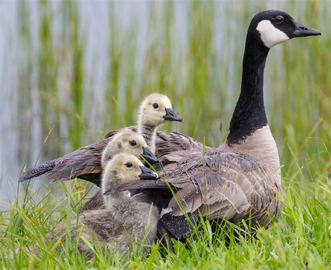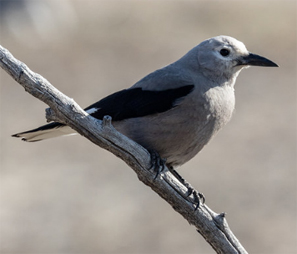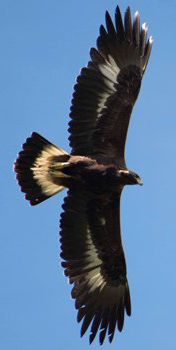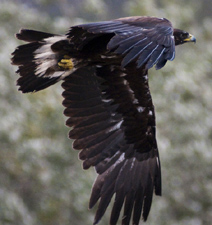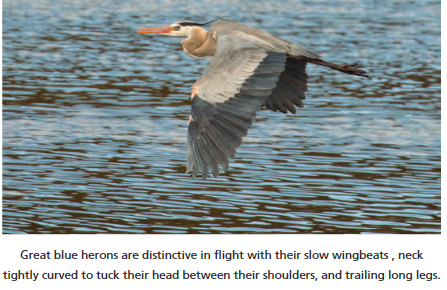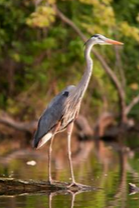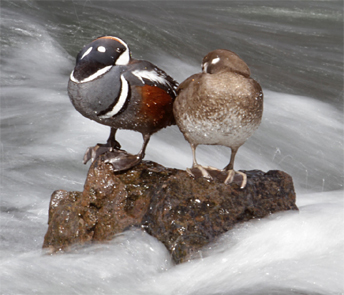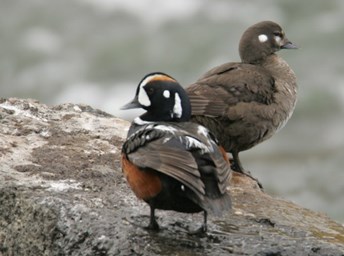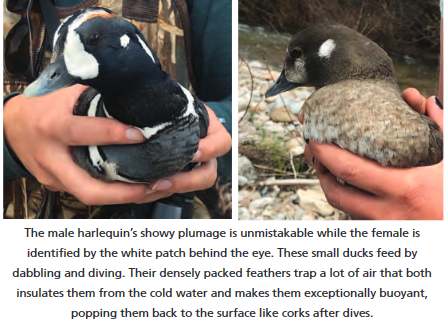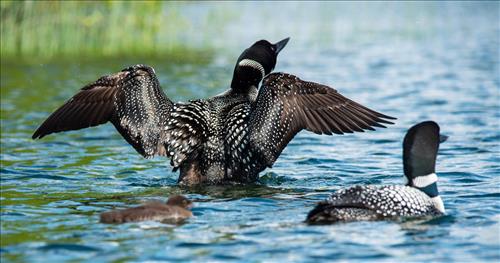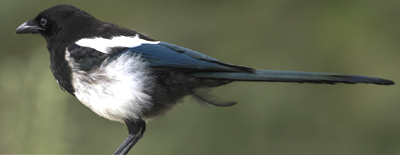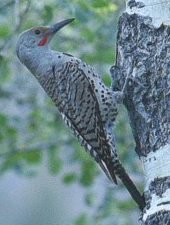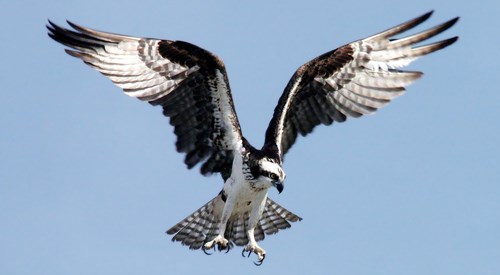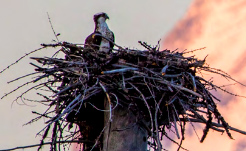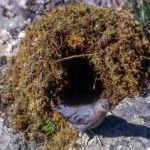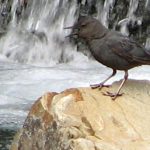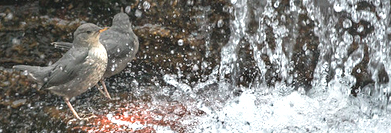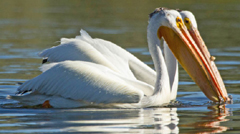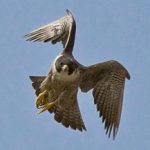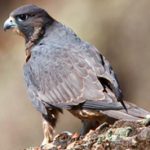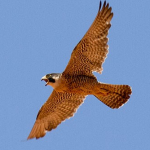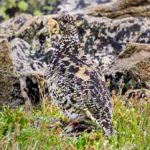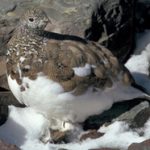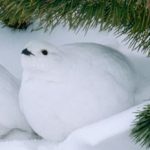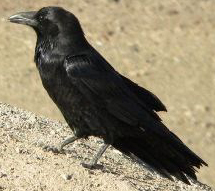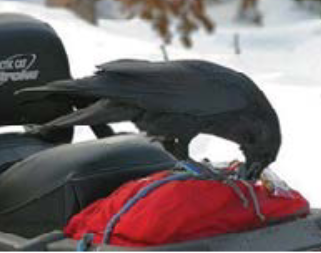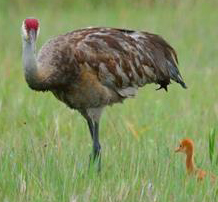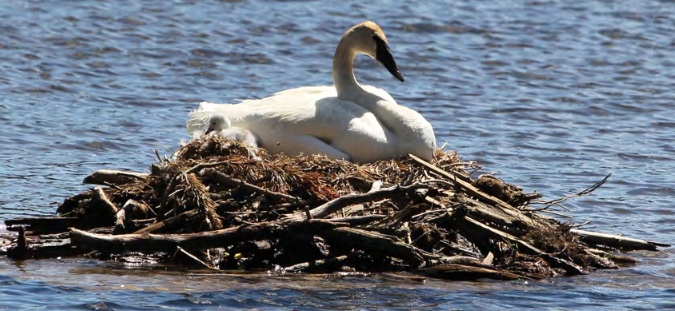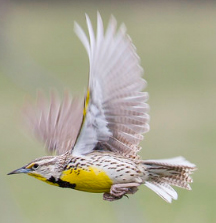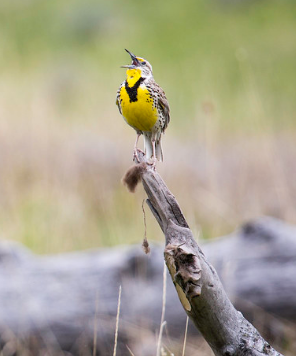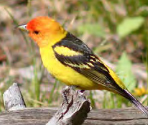At this page, in this order:
Bald Eagle
Barred Owl
Barrows Goldeneye
Red-winged Blackbird
Mountain Bluebird
Mountain Chickadee and Black-capped Chickadee
Canada Geese
Clark’s Nutcracker
Golden Eagle
Red-tailed Hawk
Swainson’s hawk
Great Blue Heron
Great Gray Owl
Great-horned Owl
Harlequin duck
Hummingbird
Ruby-crowned Kinglet
Loon
Magpie
Merganser
Northern Flicker
Osprey
Ouzel
Pelican
Peregrine Falcon
Ptarmigan
Raven
Sandhill Cranes
Steller’s Jays
Trumpeter Swan
Western Meadowlark
Western Tanager
Download and print a bird checklist from Yellowstone National Park (almost the same as Grand Teton) https://www.nps.gov/yell/learn/nature/upload/274-Bird-Checklist-2021.pdf
A northern rockies area bird watcher noted the arrival of birds migrating into the region in about this order: “long before the snowpack begins to shrink, typically in the first week of March, Mountain Bluebirds appear in Yellowstone,” followed by American Robins, Red-winged Blackbirds, Sandhill Cranes, and Western Meadowlarks.
“Red-Tailed Hawks began showing up in droves throughout the first week in April, with other raptors (Peregrine Falcons and Osprey on 4/5, Turkey Vultures on 4/6, and Sharp-shinned Hawks on 4/9) in close pursuit. On April 18, there were 9 different duck species at Slough Creek including wigeons, gadwalls, and Yellowstone’s three types of teals,” followed by American Kestrels and Wood Ducks.
Owls at this page include: Barred Owl, Great Gray Owl and Great-horned Owl.
The NPS notes: “Owls have large, fixed eyes at the front of their head. Because their eyes can’t move, they must turn their heads to see an object to the side. Owls have very flexible necks with 14 cervical vertebrae and can turn their heads up to 270 degrees in either direction. This allows them to see more than a full circle of vision. They have binocular vision and can focus both eyes at once on an object for accurate depth perception. They can see during the day, but hunt at night when their prey is out. To adjust to the bright daylight, owls can close their pupils to a pinhole and lower their top eyelid. Scientists believe owls are color blind, seeing only shades of black, white, and gray. Their eyes have very few cones for color detection, but they have lots of rods for light reception. Their eyes are 100 times more sensitive to light than human eyes.”
Different owls have many ways of delivering their hoot calls, for example:
-as described by Daniel Matthews in Rocky Mountain Natural History-
(Great Horned Owl) long, low hoots – 4 to 8 in a row,
(Great Gray Owl) 4 to 6 low hoots evenly spaced,
(Boreal Owl) 8 to 15 rapid, staccato hoots on one note,
(Barred Owl) 6 to 9 strident, reedy hoots like a deep voiced rooster
(Northern Pygmy Owl) steady hoots like whistling, a bit faster than 1 per second.
Bald Eagle
adult who just caught a fish:
This next photo is courtesy of Tom Ingram Photography, all rights reserved tomingramphotography
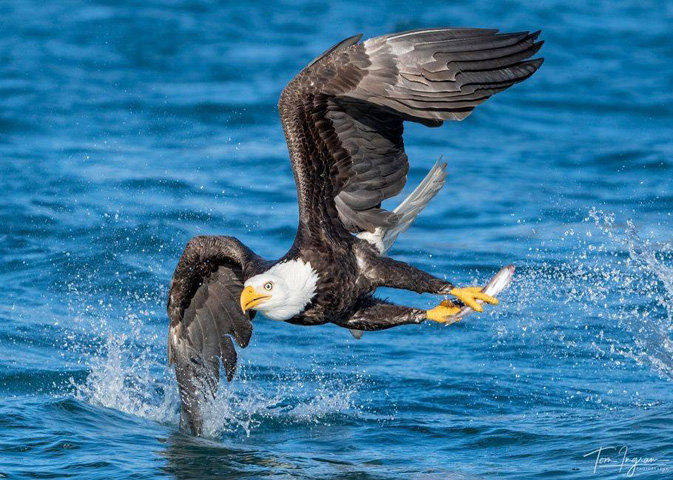
NPS photos of adult and juvenile Bald Eagles:
The juvenile Bald Eagle above will not get white head feathers until it is about 4 to 5 years old and can be mistaken for a Golden Eagle until then.
Adult Bald Eagles have a wingspan of 6 to 7.5 feet (182cm-229cm).
They rarely flap their wings; they soar instead.
Hear a Bald Eagle (webpage labeled as a Golden Eagle, but when I linked to it, had Bald Eagle sounds).
More photos of Bald Eagles on our college trips are here.
Barred Owl (Strix varia)
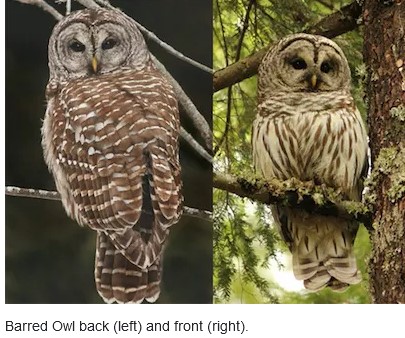
length 21 in (53 cm), wingspan 42 in (106.7 cm) Barred owls have brown-streaked pale feathers, darker on the back and wings, with yellow-orange bills. They have round heads, broad wings, and short tails.
Hear Barred Owl calls here.
Barrows Goldeneye
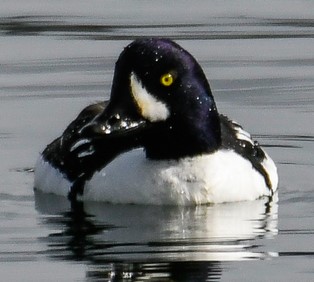

Red-winged Blackbird
“Most common bird on the North American continent. Male red-wings are polygynous and may have up to three mates each summer. Males defend territories of up to 1/4 acre by displaying their red patches to other males and by calling. Females are brown above with heavily streaked breasts.”
Red-winged Blackbird calls can be heard here.
https://academy.allaboutbirds.org/a-flash-of-brilliance-red-winged-blackbird-territorial-displays/
Mountain Bluebird (Sialia currucoides)

length 7.25 in (18.4 cm), wingspan 14 in (35.5 cm)
“Adult males are blue overall. Females are grey, with pale blue on the tail and flight feathers. Some females (and occasionally males) can have reddish coloring mixed in on the breast and throat, with a pale chin.
They forage by perching on shrubs or tall grasses and often hover before catching prey on the ground or in mid-air.” Found in sagebrush flats.
Mountain Bluebird calls can be heard here:
https://www.nps.gov/yell/learn/photosmultimedia/sounds-mountainbluebird.htm
Canada Geese , 25 inches long, who mate for life, are often seen in flocks.
Canada Geese calls can be heard here.
Mountain Chickadee (Poecile gambeli) and Black-capped Chickadee (Poecile atricapillus)
Males, females, and juveniles share the same plumage
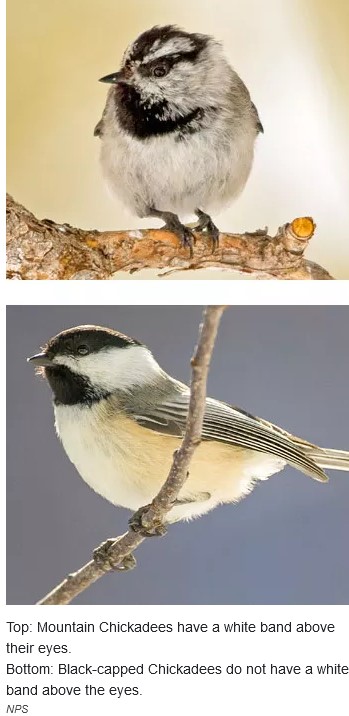
Clark’s Nutcracker (Nucifraga-columbiana): “Both males and females tend a high-elevation nest. They gather large conifer seeds from whitebark and limber pines and cache them for later.”
Hear a Clark’s Nutcracker
Golden Eagles hunt farther away from water and nest along cliffs.
https://academy.allaboutbirds.org/golden-eagle-in-a-hunting-stoop/
https://academy.allaboutbirds.org/golden-eagle-lifting-off-and-flying-through-the-snow/
https://academy.allaboutbirds.org/golden-eagle-soaring-on-a-thermal/
Red-tailed Hawk
weighs from 690 to 1,600 g (1.5 to 3.5 lb)
45–65 cm (18–26 in) in length,
wingspan from 110–141 cm (3 ft 7 in–4 ft 8 in).
A Park Ranger had this description: “Red-tailed hawks are top predators. In the words of author Pete Dunne, “…anything readily available and catchable is an odds-on favorite to become prey. Any furred, feathered, or scaled creature that is smaller than a groundhog and turns its back on a meal-minded red-tailed hawk might safely be said to be courting a shortcut toward the cosmic.” Dunne’s poetic description does not exaggerate. These hawks can perch upon a tree branch for hours on end, patiently waiting for an unsuspecting mammal, reptile or bird to consume. Many factors allow the mighty red-tailed hawk to enjoy its position as one of nature’s top predators, including powerful and sharp talons, patience, and incredible vision. For example, red-tailed hawks can see near ultraviolet light that humans cannot; special oil droplets in the receptor cells may increase their ability to see contrasts in colors. It is likely that they can see more details and richer colors than we do – even from the same vantage point.”
https://www.nps.gov/yose/blogs/Red-tailed-Hawk-One-of-Natures-Top-Predators.htm
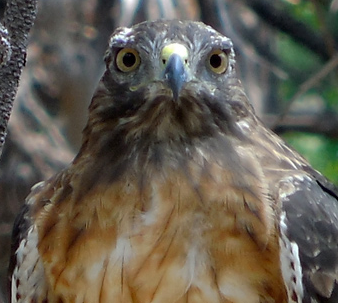
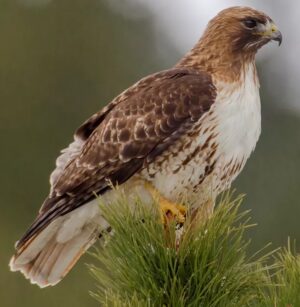
![]()
Swainson’s hawk
The NPS notes: “This versatile hawk can hunt from a perch, while soaring, or while walking on the ground. Its diet consists of rodents, snakes, grasshoppers, and other insects. Usually solitary, like other hawks, it joins large flocks while migrating. During migration, Swainson’s hawks fly about 125 miles per day until reaching their destination in South America. Their wingspan averages about four and a half feet.”
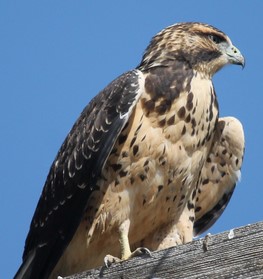
Great Blue Heron (sometimes referred to as a crane) “the largest heron in North America. Often seen standing silently along inland rivers or lakeshores, or flying high overhead, with slow wingbeats, its head hunched back onto its shoulders.” Length 38.2 – 53.9 inches (97-137 cm), Wingspan: 65.8 – 79.1 inches (167-201 cm)
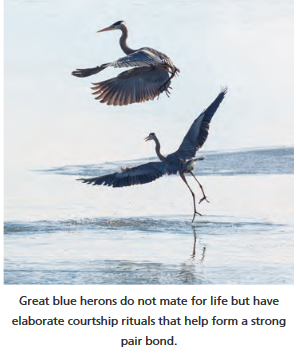
Great-horned owl (Bubo virginianus)
” is the quintessential “hoot owl” with its low “hoo-hoo-hoo”. It is found in wooded habitats and may be seen perched in silhouette at dusk . . . “usually nocturnal bird of prey can be up to 25 inches (63.5 cm) long and weigh 3 pounds (1.4 kg). Its prominent ear tufts, white bib, and geographic color and size variations distinguish it from other owl species.”
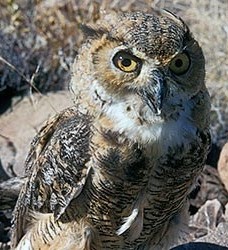
Great Gray Owls are “the tallest owl in North America with the largest wingspan. Males hunt during daylight making them visible in the lodgepole forest.”
Harlequin ducks are very strong swimmers, even in whitewater.
Harlequin ducks migrate for the winter from the Rocky Mountains to the Pacific Coast. Read more at: https://www.nps.gov/articles/harlequin-ducks.htm
Hummingbirds in Grand Teton National Park include
Selasphorus platycercus – Broad-tailed Hummingbird
Selasphorus rufus – Rufous Hummingbird
Stellula calliope – Calliope Hummingbird
Photos below of Broad-tailed Hummingbird and Rufous Hummingbird:
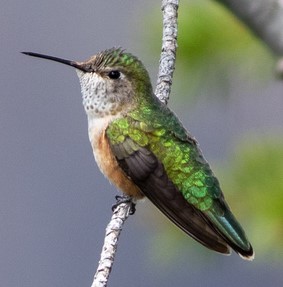
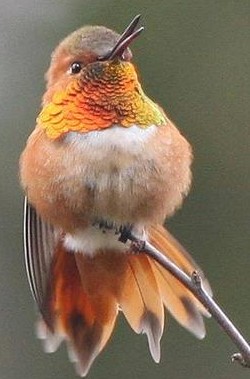
(The smallest hummingbirds weigh a little more than a penny.)
Ruby-crowned Kinglet “eats insects, other invertebrates, and fruits by hovering and snatching from the tree canopies. It nests in conifer twigs, hanging above the ground. ruby-crowned kinglets have a solid head coloring with a white eye ring. Male adults have a red crest, visible when raised. Otherwise they are colored a pale olive-grey. Length 4.25 in (11 cm), wingspan 7.5 in (19 cm)
Calls: https://search.macaulaylibrary.org/catalog?taxonCode=ruckin&view=list&mediaType=audio
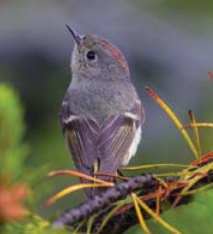
Common Loons sometimes nest on back-county lakes we have stayed overnight at.
(Loons are unable to walk on land.) The NPS says (https://www.nps.gov/articles/common-loon-brief.htm) ; “Loons are agile swimmers. Large, webbed feet and legs set far back on their bodies allow these birds to powerfully propel themselves underwater as well as in takeoff. In order to achieve flight, they run on top of the water, flapping their wings to gain enough momentum for liftoff. These traits do, however, make it difficult for loons to walk on land and make takeoff virtually impossible in a small body of water. Loons are only found on land when mating or nesting, or if sick or injured.”
Loons have the ability to dive as deep as 60 meters (200 feet) for as long as 3 minutes.
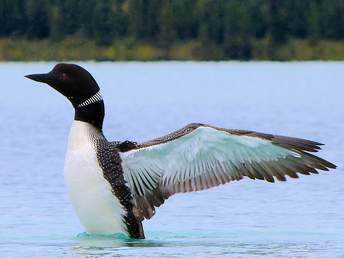
Loon tremolo calls can be heard here
https://academy.allaboutbirds.org/im-here-where-are-you-the-wails-of-the-common-loon/
Magpie: (also known as a Black-Billed Magpie)
These pictures are from a video we shot of Magpies darting in and out trying to get bits of a fish,
or even get the Bald Eagle eating the fish to fly off and leave the fish behind:
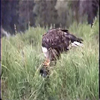
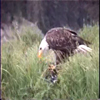
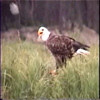
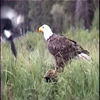
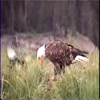
Magpie sounds can be heard here.
Merganser,
We regularly see Mergansers with chicks swimming behind mom in a row and diving on all the lakes and the Snake River, especially at the Oxbow.
Northern Flickers, (woodpecker), about 11-12 inches long, sometimes nest in hollow Aspen trees.
Northern Flicker calls and rattle calls can be heard here and here.
Northern Flicker, Hairy Woodpecker, Red-headed Woodpecker, Red-bellied Woodpecker and Downy Woodpecker for comparison:

Birder George Bumann noted, in his book Eavesdroppping on Animals “….woodpeckers combine sound and motion when they communicate. . . each woodpecker has a learned percussive pattern that is their surrogate for a songbird’s tune . . . In North America, Downy woodpeckers give fifteen to twenty-five beats lasting one to one-and-a-half seconds. The downy often lives alongside a slightly larger look-alike, the hairy woodpecker. The latter produces a more fevered pitch that is roughly two taps for every one of the downy’s. The yellow-bellied sapsucker of eastern North America and the red-napped sapsucker of the west begin their pounding in a rapid fashion, then quickly taper off, into every more widely spaced pairs of taps that make it sound a bit like they’re running out of gas. . .”
Osprey (fish hawk) hunt along the water, often in the vicinity of Bald Eagles. Osprey are 23 inches long and have a wingspan of 50-71 inches (127-180 cm). “Osprey lay two to three eggs in May to June. Fledglings (young birds) have light edges on each dark feather on their backs and upper wings, which gives them a speckled appearance.”
When you get used to the huge size of nests of Osprey, (and Bald Eagles) often built on top of a dead tree you will spot them better.
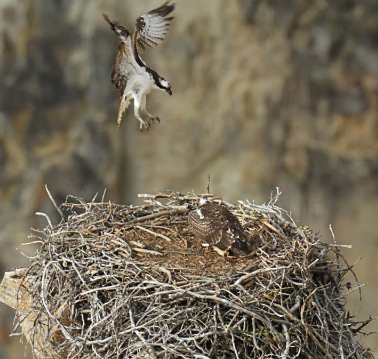
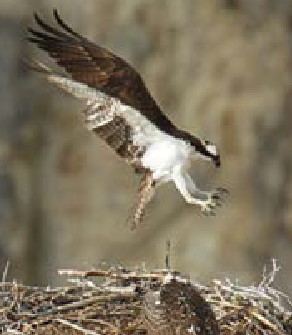
An Osprey in flight with a just caught fish:
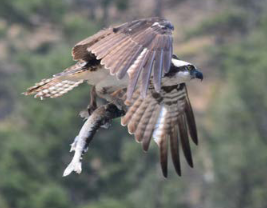
Water Ouzels (also known as American Dippers) live and play in the water. We have regularly seen them in Cascade Canyon, especially where the trail gets fairly close to the water farther up the trail, higher up in the canyon. Naturalist John Muir said the ouzel was his favorite bird, and wrote: ” . . . “the little ouzel is flitting from rock to rock along the rapid swirling Canon Creek, diving for breakfast in icy pool . . . not web-footed, yet he dives fearlessly into foaming rapids, seeming to take the greater delight the more boisterous the stream . . .” Muir wrote an entire chapter about ouzels, (chapter XIII) in The Mountains of California, which you can read at:http://www.gutenberg.org/ebooks/10012
Ouzels build their nests in the spray of water.
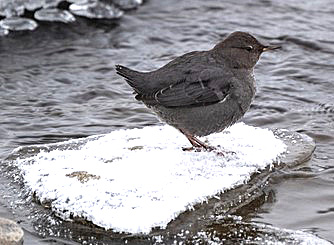
The NPS notes;”To survive in cold waters during the winter, the (ouzel) American Dipper has a low metabolic rate, extra oxygen-carrying capacity in its blood, and a thick coat of feathers.” . . “dippers have a substantial layer of down helping to insulate their bodies. Not only does the thick layer of down help to insulate, it also helps to repel water. As if that weren’t enough, the dipper has large preen glands (uropygial glands) helping to produce an oily wax that makes their plumage even more waterproof. A third eyelid, otherwise known as a nictitating membrane, acts like a goggle and allows them to see underwater. The list of other physiological elements assisting the dipper includes: special scales that slide to cover their nostrils while diving, their amazing ability to maintain internal body temperatures despite outside temperatures dropping down to as low as -22°F, along with high oxygen capacity and hemoglobin levels that allow them to store more oxygen while diving. ”
Ouzel sounds can be heard here.
Besides swans, other huge white birds are pelicans , (not the same as the Brown Pelicans we see along the Pacific coast), if they have a huge yellow beak and throat pouch.
Peregrine Falcon:
There can be closures from May to August at Baxter’s Pinnacle and Descent Gully near the mouth of Cascade Canyon to protect an active Peregrine Falcon nest.
Watch a great video from Yosemite National park about saving Peregrine Falcons, with footage of them diving at speeds faster than a commercial airplane:
https://www.nps.gov/media/video/view.htm?id=53135A56-4998-4D6E-B26D-24FE0ACCA1C3
The NPS tells us: “The peregrine falcon is the fastest animal on earth. Soaring hundreds of feet in the sky, the peregrine falcon uses its keen eyesight to spot smaller birds, such as waterfowl, doves, and song birds. With its prey in sight, the peregrine falcon will fold its wings back, and dive towards its target. Reaching speeds of over 200 miles per hour—faster than a NASCAR racer—the peregrine falcon snatches its prey out of mid-air.”
Ptarmigan do not migrate when winter comes, but change the color of their plumage each season to blend in with their surroundings.
The NPS notes; “The White-tailed Ptarmigan leads a very sedentary lifestyle in winter. They conserves precious energy by avoiding flight and often roost in snow banks. Warm weather may stress the White-tailed Ptarmigan. It can be seen bathing in snow when the temperature is higher than 21° C (70° F)”. . . “Within 6-12 hours of hatching, the female leads her clutch of 4-8 chicks to food sources where they are able to feed themselves. They do not return to the nest. . .”
Raven (bigger than a Crow you might see at home, Ravens are 24 inches long and have a wingspan of 53 inches, Crows are 17.5 inches long and have a wingspan of 39 inches).
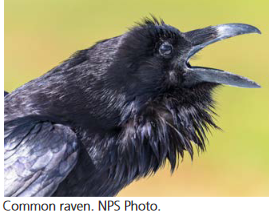
Ravens want to get into your gear, and some ravens have figured out how to get into day packs
(they can unzip or unfasten many different kinds of buckles and latches)
or . . . a bag tied onto a motorcycle:
Raven sounds can be heard here and here.
https://academy.allaboutbirds.org/caw-vs-croak-inside-the-calls-of-crows-and-ravens/
Birder George Bumann noted, in his book Eavesdroppping on Animals he “could easily identify a raven in flight by its longer wings and wedge shaped tail, and it’s tendency to soar in the wind instead of constantly flapping the way crows do. . . Distinguish the raven by any number of throaty caws, croaks and quarks, so different from the clear, higher pitched calls of the American Crow. ”
Getting to experience Sandhill Cranes singing is a favorite part of our trips, especially when we are lucky enough to see pairs dancing.
Yellowstone park notes they are the “tallest birds in Yellowstone, they stand about 4 feet (1.2 m) high. They have a wingspan of approximately 6.5 feet (2 m) and are often mistaken for standing humans or other animals at a distance.”
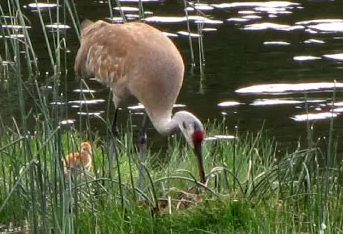
Sandhill Crane songs can be heard here and here.
Steller’s Jays have a mid-to-deep blue coloring with charcoal black shoulders and a crest at the back of their head.
Read about the structural color (as opposed to pigmented color) of Jay feathers.
Kenai Fjords National Park notes: “The wings of jays are short and rounded, allowing them more maneuverability through dense trees, and a long, rounded tail acts like a rudder to improve maneuverability as well. Their flight pattern is often a few flaps followed by a glide as they lose altitude. Jays must beat their wings repeatedly to climb back up again. . . Steller’s jays might be considered the alarm system for surrounding communities. Their call is a cheeky, repetitive “shack, shack, shack” and is often recognized as a warning call by other birds and mammals in the area. As with many of the Corvidae family, jays are excellent mimics. Scientists have studied jays repeating the call of the red-tailed hawk to scare away predators.”
Steller’s Jays want to get at your food:
Steller’s Jay calls can be heard here.
How to draw a Steller’s Jay:
https://www.nps.gov/yose/planyourvisit/upload/howtodrawaSTELLERSJAY.pdf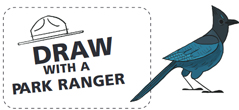
Trumpeter Swan: can be found (according to the park) at: “Oxbow Bend, Swan Lake and Flat Creek in the National Elk Refuge.” We have also seen them at Christian Pond. “The largest waterfowl in North America is making a comeback after near extinction in the early 1900s.”
NPS notes: “The trumpeter swan, named for its call, is North America’s largest wild waterfowl, with a wingspan up to eight feet.
They need 300 feet (91 m) of open water to take flight.
They can sleep on land or in the water.
Cygnets (baby swans) will stay with their mother for six months.”

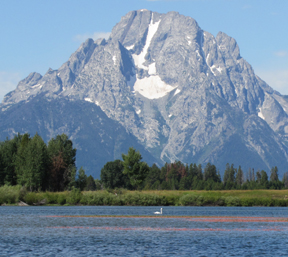
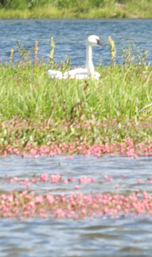

The difference between a tundra swan and a trumpeter swan (wingspan of 6 feet, 2 inches to 8 feet, 2 inches(185 to 250 cm)) is that the tundra swan has a yellow spot near the eye and the trumpeter swan has a thin pink stripe at the base of their upper mandible.
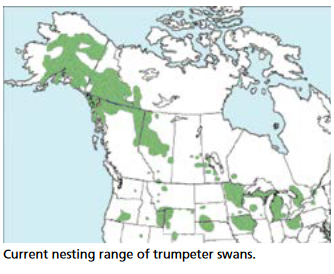
Western Meadowlark: feeds (on seeds and insects) and nests on the ground (most concealed with roof woven from grass) in / around meadows and marsh edges.
Western Meadowlark calls can be heard here.
Western Tanager “These colorful birds winter in southern Central America and nests in the lodgepole forests. The redder the male’s feathers, the more fit he is.” “The red pigment in the face of the Western Tanager is rhodoxanthin, a pigment rare in birds. It is not manufactured by the bird, as are the pigments used by the other red tanagers. Instead, it must be acquired from the diet, presumably from insects that themselves acquire the pigment from plants.”
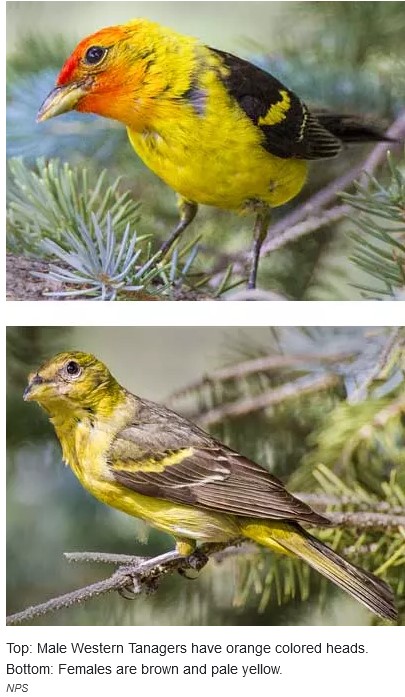
Many of the above are the birds we see most frequently on our Outdoor Club trips to Grand Teton National Park. We most often see them when we are out kayaking, especially on Oxbow Bend.
 The club brings a few pairs of waterproof binoculars, but not enough for each person in a large group.
The club brings a few pairs of waterproof binoculars, but not enough for each person in a large group.
You will really want your own binoculars.
and a telephoto lens / tripod for your camera.
Grand Teton National Park offers these Bird Watching Etiquette tips:
• Nesting birds are easily disturbed. If an adult on a nest flies off at your approach or circles you and screams an alarm, you are too close. Unattended nestlings quickly succumb to predation or exposure to the elements.
• Do not feed birds or any wildlife.
• Do not play bird songs or use bird calls. Such sounds disturb territorial males and nesting pairs.
• Stay on trails to preserve delicate habitat.
• Obey all wildlife closures.
• Good birding areas often attract other wildlife. Maintain a distance of at least 100 yards from wolves and bears and 25 yards from other animals. Do not position yourself between a female and her offspring.

Download photos of over a hundred birds of Grand Teton National Park
https://www.audubon.org/climate/national-parks/grand-teton-national-park
and see Birding in Wyoming https://www.audubon.org/news/birding-wyoming
Download this instead of buying it at a visitor center, (well worth looking at for info about animals and much more): https://www.nps.gov/yell/learn/resources-and-issues.htm
and see:
https://www.nps.gov/grte/learn/nature/upload/Vital-Signs-2019-final-web-access.pdf
We always recommend reading about the brains and abilities of corvids (Crows, Ravens, Magpies, Clark’s Nutcracker and Jays)
Gifts of the Crow How Perception, Emotion, and Thought Allow Smart Birds to Behave Like Humans.
Nests: The NPS noyes that “Birds are engineers who build their nests to be invisible, inaccessible, or impenetrable. Thus, they improve the survival of eggs, chicks, and parents. Nests can be more than woven bowls in trees. Kingfishers dig burrowsand woodpeckers chisel tree cavities. Some birds even nest together.”
Many birds navigate using the sun or stars position in the sky. https://www.nps.gov/grte/learn/nature/what-is-migration.htm
advice from the National Park Service:
“Please do not touch or pick up baby birds , fawns or other young wildlife.
This time of year” (spring, summer), “many baby birds, fawns, and other young wildlife can be found on the ground. These animals may appear to be in trouble, but are NOT orphaned, sick, or injured. These animals should be left alone. They should not be moved or handled. Otherwise, their parents will not be able to find them and continue to care for them.
When birds first leave the nest, they are often not yet able to fly. They will remain on the ground or in low bushes, and the parents will continue to come back and feed them. Leaving a baby bird where you find it is the best way to ensure that it continues to get the care it needs to survive.”
The park service offered this list of birds of Grand Teton National park:
Accipiter cooperii – Cooper’s Hawk
Accipiter gentilis – Northern Goshawk
Accipiter striatus – Sharp-shinned Hawk
Aquila chrysaetos – Golden Eagle
Buteo jamaicensis – Red-tailed Hawk
Buteo lagopus – Roughleg, Rough-legged Buzzard, Rough-legged Hawk
Buteo regalis – Ferruginous Hawk
Buteo swainsoni – Swainson’s Hawk
Circus cyaneus – Northern Harrier
Haliaeetus leucocephalus – Bald Eagle
Cathartes aura – Turkey Vulture
Pandion haliaetus – Osprey, Western Osprey
Aix sponsa – Wood Duck
Anas acuta – Northern Pintail
Anas americana – American Wigeon
Anas clypeata – Northern Shoveler
Anas crecca – Eurasian Teal, Green-winged Teal
Anas cyanoptera – Cinnamon Teal
Anas discors – Blue-winged Teal
Anas platyrhynchos – Mallard
Anas strepera – Gadwall
Aythya affinis – Lesser Scaup
Aythya americana – Redhead
Aythya collaris – Ring-necked Duck
Aythya valisineria – Canvasback
Branta canadensis – Canada Goose
Bucephala albeola – Bufflehead
Bucephala clangula – Common Goldeneye
Bucephala islandica – Barrow’s Goldeneye
Chen caerulescens – Blue Goose, Snow Goose
Cygnus buccinator – Trumpeter Swan
Histrionicus histrionicus – Harlequin Duck
Lophodytes cucullatus – Hooded Merganser
Mergus merganser – Common Merganser
Mergus serrator – Red-breasted Merganser
Oxyura jamaicensis – Ruddy Duck
Selasphorus platycercus – Broad-tailed Hummingbird
Selasphorus rufus – Rufous Hummingbird
Stellula calliope – Calliope Hummingbird
Chordeiles minor – Common Nighthawk
Charadrius vociferus – Killdeer
Chilidonias niger – Black Tern
Larus californicus – California Gull
Larus delawarensis – Ring-billed Gull
Larus pipixcan – Franklin’s Gull
Sterna caspia – Caspian Tern
Sterna hirundo – Common Tern
Recurvirostra americana – American Avocet
Actitis macularia – Spotted Sandpiper
Catoptrophorus semipalmatus – Willet
Gallinago gallinago – Common Snipe
Limnodromus scolopaceus – Long-billed Dowitcher
Limosa fedoa – Marbled Godwit
Numenius americanus – Long-billed Curlew
Phalaropus tricolor – Wilson’s Phalarope
Tringa flavipes – Lesser Yellowlegs
Tringa melanoleuca – Greater Yellowlegs
Tringa solitaria – Solitary Sandpiper
Columba livia – Common Pigeon, Rock Dove, Rock Pigeon
Zenaida macroura – Mourning Dove
Ceryle alcyon – Belted Kingfisher
Falco columbarius – Merlin
Falco mexicanus – Prairie Falcon
Falco peregrinus, Falco peregrinus anatum – American Peregrine Falcon
Falco sparverius – American Kestrel
Bonasa umbellus – Ruffed Grouse
Centrocercus urophasianus – Greater Sage Grouse, Greater Sage-Grouse, Sage Grouse
Dendragapus obscurus – Blue Grouse
Gavia immer – Common Loon, Great Northern Diver, Great Northern Loon
Grus canadensis – Sandhill Crane
Coturnicops noveboracensis – Yellow Rail
Fulica americana – American Coot
Porzana carolina – Sora
Rallus limicola – Virginia Rail
Eremophila alpestris – Horned Lark
Bombycilla cedrorum – Cedar Waxwing
Bombycilla garrulus – Bohemian Waxwing
Plectrophenax nivalis – Snow Bunting
Passerina amoena – Lazuli Bunting
Pheucticus melanocephalus – Black-headed Grosbeak
Piranga ludoviciana – Western Tanager
Certhia americana – Brown creeper
Cinclus mexicanus – American Dipper, Ouzel
Corvus brachyrhynchos – American Crow
Corvus corax – Common Raven, Northern Raven
Cyanocitta stelleri – Steller’s Jay
Nucifraga columbiana – Clark’s Nutcracker
Perisoreus canadensis – Gray Jay, Grey Jay
Pica hudsonia, Pica pica – Black-billed Magpie, Eurasian Magpie
Chondestes grammacus – Lark Sparrow
Junco hyemalis – Dark-eyed Junco
Melospiza lincolnii – Lincoln’s Sparrow
Melospiza melodia – Song Sparrow
Passerculus sandwichensis – Savannah Sparrow
Passerella iliaca – Fox Sparrow, Red Fox Sparrow
Pipilo chlorurus – Green-tailed Towhee
Pooecetes gramineus – Vesper Sparrow
Spizella breweri – Brewer’s Sparrow
Spizella passerina – Chipping Sparrow
Zonotrichia leucophrys – White-crowned Sparrow
Carduelis pinus – Pine Siskin
Carduelis tristis – American Goldfinch
Carpodacus cassinii – Cassin’s Finch
Carpodacus mexicanus – House Finch
Coccothraustes vespertinus – Evening Grosbeak
Leucosticte atrata, Leucosticte arctoa – Black Rosy-Finch
Leucosticte tephrocotis – Gray-crowned Rosy-finch
Loxia curvirostra – Red Crossbill
Loxia leucoptera – Two-barred Crossbill, White-winged Crossbill
Pinicola enucleator – Pine Grosbeak
Hirundo rustica – Barn Swallow
Petrochelidon pyrrhonota, Hirundo pyrrhonota – Cliff Swallow
Riparia riparia – Bank Swallow, Sand Martin
Stelgidopteryx serripennis – Northern Rough-winged Swallow
Tachycineta bicolor – Tree Swallow
Tachycineta thalassina – Violet-green Swallow
Agelaius phoeniceus – Red-winged Blackbird
Dolichonyx oryzivorus – Bobolink
Euphagus cyanocephalus – Brewer’s Blackbird
Icterus bullockii – Bullock’s Oriole
Molothrus ater – Brown-headed Cowbird
Quiscalus quiscula – Common Grackle
Sturnella neglecta – Western Meadowlark
Xanthocephalus xanthocephalus – Yellow-headed Blackbird
Lanius excubitor – Great Grey Shrike, Northern Shrike
Lanius ludovicianus – Loggerhead Shrike
Dumetella carolinensis – Gray Catbird, Grey Catbird
Oreoscoptes montanus – Sage Thrasher
Anthus rubescens, Anthus spinoletta – Water Pipit
Poecile atricapillus, Parus atricapillus – Black-capped Chickadee
Poecile gambeli – Mountain Chickadee Parus gambeli
Dendroica coronata – Yellow-rumped Warbler
Dendroica petechia – American Yellow Warbler, Yellow Warbler
Dendroica townsendi – Townsend’s Warbler
Geothlypis trichas – Common Yellowthroat
Oporornis tolmiei – MacGillivray’s Warbler
Seiurus noveboracensis – Northern Waterthrush
Vermivora celata – Orange-crowned Warbler
Wilsonia pusilla – Wilson’s Warbler
Regulus calendula – Ruby-crowned Kinglet
Regulus satrapa – Golden-crowned Kinglet
Sitta canadensis – Red-breasted Nuthatch
Sitta carolinensis – White-breasted Nuthatch
Sitta pygmaea – Pygmy Nuthatch
Sturnus vulgaris – Common Starling, European Starling
Cistothorus palustris – Marsh Wren
Salpinctes obsoletus – Rock Wren
Troglodytes aedon – House Wren
Troglodytes troglodytes – Winter Wren
Catharus guttatus – Hermit Thrush
Catharus ustulatus – Swainson’s Thrush
Ixoreus naevius – Varied Thrush
Myadestes townsendi – Townsend’s Solitaire
Sialia currucoides – Mountain Bluebird
Turdus migratorius – American Robin
Contopus cooperi, Contopus borealis – Olive-sided Flycatcher
Contopus sordidulus – Western Wood Pewee, Western Wood-Pewee
Empidonax hammondi – Hammond’s flycatcher
Empidonax oberholseri – Dusky Flycatcher
Empidonax occidentalis, Empidonax difficilis – Cordilleran Flycatcher
Empidonax traillii – Willow Flycatcher
Tyrannus tyrannus – Eastern Kingbird
Tyrannus verticalis – Western Kingbird
Vireo gilvus – Warbling Vireo
Vireo plumbeus, Vireo solitarius – Plumbeous Vireo
Ardea herodias – Great Blue Heron
Botaurus lentiginosus – American Bittern
Egretta thula – Snowy Egret
Pelecanus erythrorhynchos – American White Pelican
Plegadis chihi – White-faced ibis
Colaptes auratus – Northern Flicker
Melanerpes lewis – Lewis’ Woodpecker, Lewis’s Woodpecker
Picoides arcticus – Black-backed Woodpecker
Picoides dorsalis, Picoides tridactylus – American Three-toed Woodpecker
Picoides pubescens – Downy Woodpecker
Picoides villosus – Hairy Woodpecker
Sphyrapicus nuchalis – Red-naped Sapsucker
Sphyrapicus thyroideus – Williamson’s Sapsucker
Aechmophorus clarkii – Clark’s grebe
Aechmophorus occidentalis – Western Grebe
Podiceps auritus – Horned Grebe
Podiceps nigricollis – Black-necked Grebe, Eared Grebe
Podilymbus podiceps – Pied-billed Grebe
Aegolius acadicus – Northern Saw-whet Owl
Aegolius funereus – Boreal Owl
Asio flammeus – Short-eared Owl
Asio otus – Long-eared Owl
Athene cunicularia – Burrowing Owl
Bubo virginianus – Great Horned Owl
Glaucidium gnoma – Mountain Pygmy Owl, Northern Pygmy-Owl
Otus kennicotti – Western Screech-owl
Strix nebulosa – Great Gray Owl, Great Grey Owl
Strix varia – Barred Owl
Tyto alba – Barn Owl, Common Barn-Owl, Western Barn Owl
Phalacrocorax auritus – Double-crested Cormorant
Yellowstone National park has a sound library.
![]()
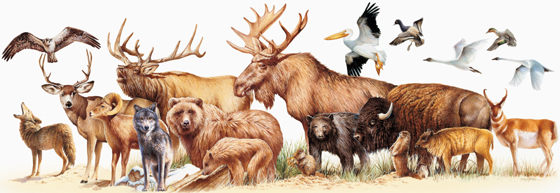
Rocky Mountain mammal size comparisons has photos and comparisons of beavers, squirrels, pika, marmot, elk, moose, bison, fox, coyote, wolf, golden-mantled ground squirrel, chipmunk, Red Squirrel (also known as) Chickaree, Unita Ground squirrels, bobcat, lynx, mountain lion (cougar), pine marten, mountain goats, bighorn sheep, pronghorn, grizzly and black bears.
Many people think of trees the shape of the ones shown below as “pine” trees,
but only one of them is actually a pine tree and we see it in Yosemite rather than on the Grand Teton Trip. If you are interested in learning more, see tree identification in Grand Teton Park.
Grand Tetons sightseeing
Hiking Advice has hot weather hiking advice, hiking logistics and the answer to the question: When is the best time of day to cross a mountain stream?
Please, no trail running
Grand Teton National park: “Trail running is strongly discouraged; you may startle a bear.”
Glacier National Park: “Trail running is discouraged as there have been an increasing number of injuries and fatalities due to runners surprising bears at close range.”
Don’t bike or jog/run by yourself, it is safer to bike in groups since there are very large, potentially dangerous and unpredictable animals potentially everywhere.
Data suggest that rates of sudden encounters with bears are much higher among cyclists than hikers.
Grand Tetons biking includes statistics about cyclist encounters with grizzly bears.
Your safety in grizzly bear territory tells you what to do if you see a bear in the distance or a bear charges you and has info about Bear Pepper Sprays and what might happen before a bison charges.
During a thunderstorm, don’t take a shower or use a sink, including washing dishes. Don’t talk on a land line phone. Don’t use your I pod. Don’t get zapped! Please read Thunderstorm and lightning safety
Road trip advice and etiquette
People often get too close to animals when they are trying to take a selfie.
Grand Tetons trip equipment.
Details about our next club trip to Grand Teton National Park start at Grand Tetons.
Grand Tetons trip pages index has brief descriptions of most of the pages about this trip.
(Note to on-line users not in my classes: this is a study sheet. It is not complete instruction in the topic named in the webpage title.)
The author of this webpage, (written as a homework reading assignment for my students), does not give any warranty, expressed or implied, nor assume any legal liability or responsibility for the accuracy, completeness, or usefulness of any information, product, or process included in this website or at websites linked to or from it. Users of information from this website assume all liability arising from such use.
